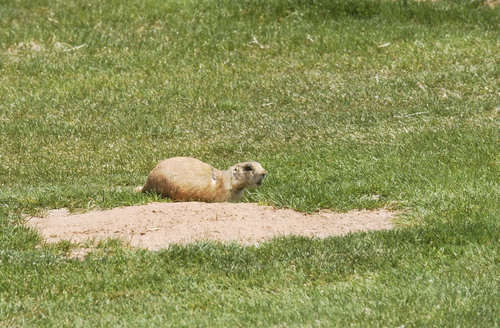This is an archived article that was published on sltrib.com in 2014, and information in the article may be outdated. It is provided only for personal research purposes and may not be reprinted.
A proposal to expand a prairie dog sanctuary on state trust lands in Wayne County could ensure survival of the rodent and increase Utah's permanent school fund by $1 million dollars, according to its proponents.
But ranchers and Wayne County leaders want the Utah School and Institutional Trust Lands Administration (SITLA) board to reject the proposed sale of 800 acres to The Nature Conservancy, claiming it would increase federal influence in a county already saddled with public lands.
And setting aside land for prairie dogs isn't even necessary, said Lyman rancher Dave Christensen. Parker Mountain, the highlands where he runs cattle southwest of Loa, already is populated with prairie dogs that the U.S. Fish and Wildlife Service (FWS) fails to count, Christensen said. He leases SITLA land on the same mountain as the proposed sanctuary expansion.
"There's not a better managed piece of land in the world for multiple use and wildlife. Why would you want to wreck that?" said Christensen, president of the Parker Mountain Grazers Association. "If The Nature Conservancy buys it, they're going to set up rules and take away the liberties people have enjoyed out there. You're going to see camping restrictions and hunting restrictions."
SITLA's Parker Mountain block exceeds 100,000 acres that straddle the Wayne and Piute county line. Much of it is in the Awapa Plateau prairie dog recovery unit, one of three in southern Utah. Surveys have recorded between 500 and 600 adult dogs there nearly every year since the feds listed the species as endangered in 1973.
But this year, the population spiked to more than 900, probably because of the mild winter, said FWS prairie dog biologist Nathan Brown.
The Nature Conservancy would buy the 800 acres on the eastern edge of the SITLA lands and establish an endowment to manage them with a $1 million FWS grant and a modest state match, Brown said.
The land abuts easements on SITLA land already managed for prairie dogs. The hope is to create "safe harbors" for the animals to proliferate without causing headaches for farmers, pilots and other humans.
"Our goals are the same as the grazers'. We would like it to be open space in perpetuity and have both prairie dogs and sage grouse," Brown said. "It seemed like a win-win situation."
In a similar deal last year, SITLA sold 800 acres in Garfield County to the conservancy.
The westernmost and most isolated of North America's five species, the Utah prairie dog is the cutest of the state's listed species. But it also is the most vexing, particularly when the dogs rear their adorable heads in Paragonah Cemetery and Parowan Airport.
More than three-fourths of Utah's 7,000 prairie dogs are on private and state trust lands, according to FWS data. Most of those don't count toward prairie dog recovery goals, much to the disgust of Christensen and many elected leaders in southwestern Utah.
The rancher alleges the feds "manipulate" the data and the law to justify keeping the prairie dog species listed, even though "millions" of the critters persist across Western and Plains states.
Meanwhile, prairie dogs burrow into agricultural fields, golf courses, cemeteries, even airport runways. Indeed, past poisoning campaigns to control such damage imperiled the survival of some prairie dog species.
Wildlife officials consider them a "keystone" species because their burrows provide habitat for other species. Purchasing land to be managed as habitat can lead to eventual delisting, officials say.
At a recent SITLA board meeting, Wayne County Commissioner Newell Harward asked the agency to abandon the Parker Mountain deal.
"Wayne County has no faith [the] prairie dog will ever be delisted. We have less than 7 square miles used for people habitat, but we will use [up to] 2,000 acres for prairie dog habitat. Folks, that doesn't make sense for a county of 2,500 people," Harward said.
His request puts the SITLA board in "a peculiar situation," said chairman David Ure, a Kamas rancher and former lawmaker.
Ure, a rancher himself, said he is sympathetic to the Wayne County ranchers, but SITLA's legislative mandate is to make money off of Utah's 3 million acres of trust lands. Usually that means drilling, mining and development, but occasionally it means conservation.
"One thing that has kept this organization out of the woodshed, we always try to be consistent," Ure told Harward.
SITLA director Kevin Carter said "99 percent of the time" SITLA's interests align with the counties'.
"It troubles us when we run into these situations when we butt heads with local leaders," Carter said. "We operate as a trust. It's a switch, not a valve. We are either a trust or we're not. Once we flip the switch, we become public lands. You are eventually going to make everyone unhappy."



